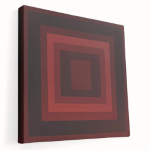In modern art and interior styling, abstract wall art has emerged as a powerful tool for evoking emotion and enriching personal spaces. By rejecting realism and embracing interpretation, abstract works communicate ideas in visual form, allowing viewers to connect on a more intuitive level. As a result, abstract wall art has earned its place as a staple in stylish homes and professional spaces alike.
The Foundation of Abstract Expression
Abstract art challenges conventional rules. Instead of focusing on realism or recognizable imagery, it presents ideas through elements like color, line, and texture. This style invites viewers to explore their feelings and associations, creating a deeply individual response to the artwork.
This makes abstract wall art more than decor—it becomes a dialogue between the artist and the viewer. Every brushstroke, curve, or contrasting color carries potential meaning. This interpretive richness is why abstract art consistently attracts attention in galleries and living rooms.
Selecting the Right Abstract Piece
Choosing the right abstract wall art for a particular room depends on several considerations. The size of the wall, the overall tone of the space, and the emotional response desired all play a part. In a space intended for relaxation, such as a bedroom, cooler tones and softer forms can promote tranquility. Conversely, a high-energy space like a home office or creative studio may benefit from bolder colors and more dynamic composition.
Framing also matters. A floating frame can modernize a piece, while a classic wooden frame might make an abstract work feel more grounded. Thoughtful framing ensures the artwork feels like a seamless part of the environment.
The orientation of abstract wall art also changes its impact. A vertical canvas can add height and elegance to a room, while horizontal pieces stretch the space visually. Large-format abstracts, particularly diptychs or triptychs, make a grand statement in open-plan settings.
Abstract Art as a Reflection of Personality
Every piece of abstract art reveals something about its owner. Whether it’s vibrant and wild or subtle and serene, the selection of such art often mirrors personal tastes, moods, or philosophies. This personal connection makes abstract wall art one of the most authentic ways to curate a space.
It allows homeowners to break free from traditional constraints. There is no need for literal storytelling or matching sets. Instead, abstract wall art encourages exploration and experimentation. It becomes a form of self-expression that evolves with the person who chooses it.
The Role of Texture and Medium
In addition to color and form, texture is another powerful aspect of abstract wall art. Whether created with oil, acrylic, mixed media, or even sculptural materials, texture adds depth and dimension. It catches light differently and invites closer inspection.
Canvas is the most common medium, but metal and wood are also used to stunning effect. These alternative materials offer a different tactile quality and visual presence. Metallic surfaces, for instance, interact beautifully with both natural and artificial lighting, creating dynamic shifts throughout the day.
Abstract Wall Art in Contemporary Interiors
In contemporary interior design, abstract art complements a wide variety of aesthetics. Clean lines and neutral palettes often form the base of modern decor. A well-placed piece of abstract wall art brings contrast and intrigue, preventing the room from feeling too sterile or mechanical.
Even in more traditional settings, abstract art can provide balance. It introduces a fresh, unexpected element that makes the space feel current. By integrating abstract wall art, designers bridge the gap between classical and modern sensibilities.
Creating a Focal Point
A single piece of abstract wall art can serve as the centerpiece of a room. Placed above a fireplace, behind a sofa, or in a hallway, it commands attention and anchors the space. When everything else in the room is designed with restraint, an abstract painting adds just the right amount of drama.
Color coordination plays a significant role. Selecting pieces that echo the room’s existing tones ensures harmony, while deliberately contrasting colors introduce tension and excitement.
Conclusion
Abstract wall art is a dynamic form of expression that transcends boundaries and sparks imagination. Whether used to provoke thought, inspire calm, or energize a room, it has a unique ability to transform spaces. Its appeal lies in its mystery and openness, making it a versatile and lasting addition to any interior. By embracing abstract art, individuals bring emotion, story, and sophistication into their environments—one canvas at a time.

